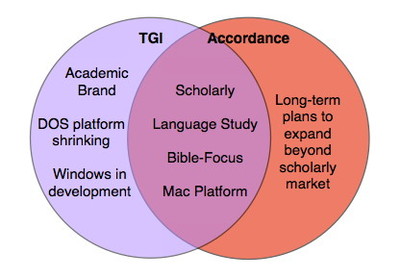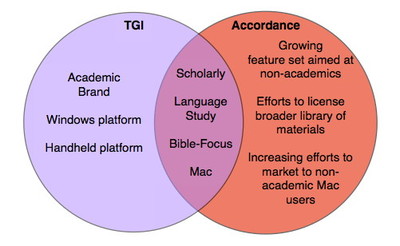Way back when Accordance was first being conceived, we established a partnership with The GRAMCORD Institute (TGI), a scholarly non-profit organization which had pioneered the development of a grammatically searchable Greek New Testament. TGI had developed software for mainframe computers back in the 1970s and for DOS PCs in the ’80s, but by the early ’90s, they needed to add support for the Macintosh and Windows platforms. They did that by establishing partnerships with independent Macintosh and Windows software developers.
The basic nature of our partnership with TGI was this: We would develop and retain ownership of the Accordance program, which would offer, among other things, a Macintosh interface for reading and searching the GRAMCORD Greek New Testament. TGI would also license other Bible texts and resources from various publishers for use with Accordance. TGI would sell Accordance to its established customer base, while we would provide all technical support.
This arrangement had a number of advantages. TGI had a solid reputation among scholars and an established presence at the high end of the Bible software market. They were already equipped to handle sales and distribution of the software, which freed us to focus on development. They also had established licensing agreements with various book publishers, which meant that we didn’t have to start building a library of materials from scratch. On the other hand, TGI would benefit by being able to sell a product to Mac users without having to develop that software themselves.
Of course, when businesses form partnerships, they’re like the intersecting circles of a Venn diagram. Where the intersection occurs, each partner benefits from the other. However, the areas where the circles do not overlap represent differences in focus, market, and expertise among the partners, and those differences can actually work to pull the circles farther apart. The smaller the amount of overlap between the circles, the less the partnership actually benefits each partner, and the greater the pull away from each other.
For example, in the beginning of our relationship with TGI, there was a significant amount of overlap between the circles.
GRAMCORD was focused on the academic market, and version 1.0 of Accordance was loaded with features aimed at that market. Likewise, TGI had licensed Bibles and some academic resources from other publishers, which fit well with Accordance’s initial focus on high-end features for study of the Biblical text. GRAMCORD was also focused on selling its DOS software, but the DOS platform was shrinking, and they had not yet released a Windows product. Accordance was therefore an exciting expansion of their product line and a sign that they were embracing graphical user interfaces. For our part, we had long-term plans to expand Accordance into a full-featured Bible program that would appeal to non-academics, but we weren’t there yet. Consequently, there was a fair amount of overlap between the two companies, and the partnership clearly benefitted both parties.
As time went on, the situation changed.
TGI’s partnerships with software developers for Windows and handheld computers eventually resulted in its offering products for those platforms. TGI naturally marketed these products as GRAMCORD for Windows, GRAMCORD for handhelds, and thus Accordance as “GRAMCORD for Mac.” Yet these were different programs from different developers with different feature sets and different libraries. Much of what made Accordance unique ended up being obscured by its identification with the GRAMCORD brand. At the same time, Accordance was expanding to become a full-featured Bible program which was no longer just aimed at academics. Our marketing, licensing, and development efforts became increasingly focused in areas that were beyond TGI’s academic focus. The more we began to negotiate our own licenses, do our own marketing, and process our own sales, the more complicated our relationship with TGI became. Eventually, we reached the point where it was necessary to strike out completely on our own.
Such transitions are never easy, but over time it became clear that we had made the right decision. By bringing everything in-house, we were able to forge our own brand identity, simplify life for our users, increase our offerings, and greatly expand the Accordance user-base.
At the same time we were managing that transition, Apple was facing a major transition of its own: the rollout of Mac OS X. Accordance 5 was the first version of Accordance we released after our partnership with TGI came to an end, and it was also the first Bible program to support Mac OS X. I’ll tell you the story of that major turning point in my next Throwback Thursday post.



